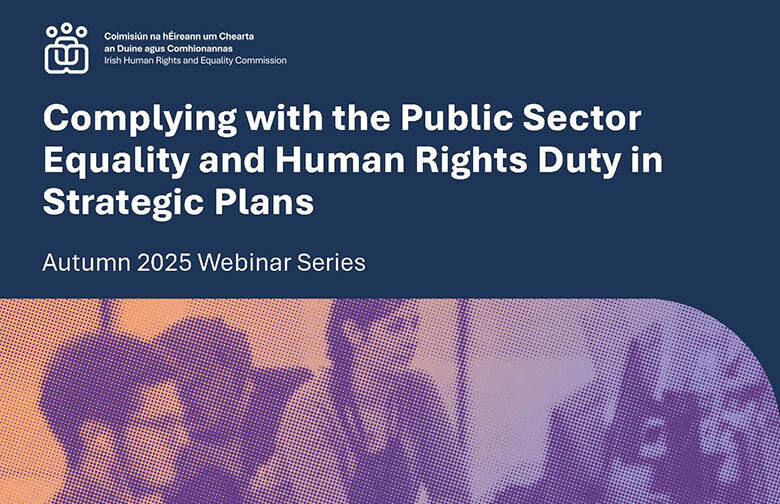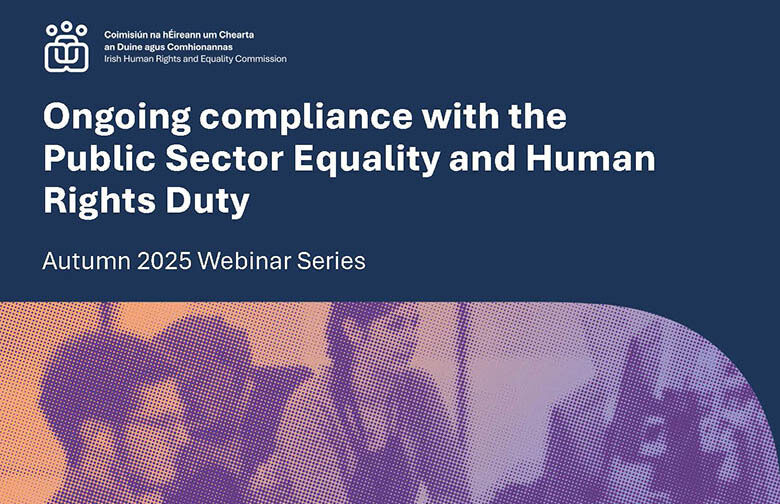What is the Public Sector Equality and Human Rights Duty?
The Public Sector Equality and Human Rights Duty (the Duty) is contained in Section 42 of the Irish Human Rights and Equality Commission Act 2014. It places a statutory obligation on public bodies to have regard to human rights and equality considerations in the performance of their functions. It is contained in Section 42 of the IHREC Act and applies to Public Bodies in the Republic of Ireland.
Why is the Duty important?
Implementing the Duty means public bodies address human rights and equality issues in a proactive way, rather than waiting until an issue or complaint arises, before addressing it. The Duty has an important role to play in supporting public bodies to deliver efficient accessible services to citizens and communities, in particular those at risk of inequality and discrimination. It supports a public service-wide approach to equality, human rights, diversity and inclusion. The Duty applies across all functions of a public body, and implementing it puts equality and human rights into the mainstream of how public bodies carry out their daily work.

What is a public body?
In the IHREC Act 2014 the definition of a public body for the purposes of the Duty includes:
- a Department of State,
- a local authority,
- the Health Service Executive,
- a university or institute of technology,
- an education and training board,
- “any other person, body or organisation established by an enactment (other than the Companies Act), by charter, by Ministerial scheme or under the Companies Act in pursuance of powers conferred by or under another enactment and financed wholly or partly by the Government, whether through the provision of funds, loans or the issuing of shares”
In addition, any other person, body, organisation or group financed wholly or partly out of moneys provided by the Oireachtas, may, in the public interest, be prescribed as a public body by the Minister for Children, Equality, Disability, Integration and Youth's mission, following consultation with the Irish Human Rights and Equality Commission. To date, no public body has been prescribed.
What do public bodies need to do?
By law, public bodies need to put in place policies and actions to:
- eliminate discrimination
- promote equality of opportunity and treatment of its staff and the people they provide services to, and
- protect the human rights of its members, staff and the people they provide services to.
They also need to:
- Assess the human rights and equality issues they believe are relevant to them
- Include that assessment in their strategic plan
- Report on developments and achievements they make on human rights and equality issues in their annual report
Implementing the Duty
Implementation of the Public Sector Equality and Human Rights Duty puts equality and human rights at the heart of how a public body carries out its daily business. The Duty encompasses both current service users and those who could and should be availing of their services but are not currently doing so. It also encompasses both current staff and those who might seek employment in the public body.
There are two key elements to Section 42 IHREC Act 2014
- Section 42(1) is the overarching statutory obligation under section 42 of the Act, which you, as a public body must comply with, on an ongoing basis. Section 42(1) requires a public body to put in place measures to ensure the promotion of equality of opportunity, elimination of discrimination and protection of human rights are incorporated into how you carryout out the day to day work of the organisation.
- Section 42(2) sets out the specific statutory obligations that you must comply with in your organisations strategic plan and annual report to support your compliance with the overarching statutory obligation in section 42(1) of the IHREC Act.
Section 42 (1) states that public bodies shall, in the performance of its functions, have regard to the need to:
(a) eliminate discrimination,
(b) promote equality of opportunity and treatment of its staff and the persons to whom it provides services, and
(c) protect the human rights of its members, staff and the persons to whom it provides services.
Section 42(1) is the overarching statutory obligation under section 42 of the Act, which you, as a public body must comply with, on an ongoing basis. To support your organisation to promote equality of opportunity, eliminate discrimination and protect human rights for service users, potential service users, staff and potential staff and demonstrate this compliance with the Duty on an ongoing basis, you should develop:
- performance measures;
- operational standards; and
- written preventative strategies.
Section 42 (2) states
A public body shall, having regard to the functions and purpose of the body and to its size and the resources available to it—
(a) carry out an assessment of the human rights and equality issues it believes to be relevant to the functions and purpose of the body (‘human rights and equality assessment’);
(b) put in place policies, plans and actions to address the issues identified in its human rights and equality assessment;
(c) publish its human rights and equality assessment, and the policies, plans and actions in place or proposed to be put in place to address the issues identified in that assessment, in a manner that is accessible to the public in its strategic plan, (howsoever described);
(d) report, in a manner that is accessible to the public, on developments and achievements – in respect of the policies, plans and actions in place or proposed to be put in place to address issues identified in its assessment - in its annual report (howsoever described).
Section 42(2) includes specific statutory obligations that you must comply with to support your compliance with the overarching statutory obligation in section 42(1) of the IHREC Act.
Section 42(2) sets out three key steps a public must take to support compliance with the statutory obligations under section 42 of the Act. The steps set out in section 42(2)
- Assess- Carryout an assessment of equality and human rights issues, relevant to the functions of the public body.
- Address- Identify the actions/policies/plans the public body propose to take to address the equality and human rights issues identify during the assess step.
- Report – Report on progress made under the Assess and Address steps in your organisation’s annual report in a manner that is accessible to the public.
Step 1 & 2 must be set out in a manner that is accessible to the public in your organisations strategic plan.
The Assess Step
The assess step requires you to undertake an assessment to identify key equality and human rights issues, for staff and service users. It involves carrying out evidence-based identification and prioritisation of the equality and human rights issues relevant to your functions and purpose. Undertaking an evidence-based assessment of equality and human rights issues will help you to identify where potential discrimination, inequality and violation of human rights may exist in the provision of services and in the workplace. The assessment should be informed from available evidence, including the knowledge and experience of your staff and people you provide services to, and in particular, from people with the lived experience of inequality and discrimination.
Your assessment of human rights and equality issues should focus on the following identified groups:
- People covered by the nine grounds under equality legislation: gender (including transgender persons or persons transitioning to another gender), civil status, family status (including lone parents and carers), age, sexual orientation, disability, race, religion, and membership of the Traveller community;
- People at risk of poverty and social exclusion; and
- Rights-holders under the various human rights instruments relevant to the functions and purpose your public body.
The Address Step
The Address step will help you to identify the actions, plans and policies you will implement to eliminate discrimination, promote equality of opportunity and treatment, and to protect the human rights of your staff and service users. The address step requires you to prioritise actions to address the equality and human rights issues you have identified, that will be implemented during the strategic planning cycle.
The address step supports you to:
- Enhance equality and human rights outcomes for your service users and policy beneficiaries;
- Enhance equality and human rights outcomes for your staff; and
Drive cultural change within your organisation, ensuring a focus on equality and human rights that shapes organisational priorities, procedures and practice.
The Report Step
The Report step will help you to identify the actions, plans and policies you have implemented to eliminate discrimination, promote equality of opportunity and treatment, and to protect the human rights of your staff and service users. The report step requires you to to review and communicate progress in relation to addressing equality and human rights issues identified in the Step 1. Assess stage of implementation. The report should draw from updates on progress provided by lead staff responsible for the indicated plans, policies, and actions; and the working group’s report on initiatives for the effective implementation of the Duty in your organisation.
How does the Irish Human Rights and Equality Commission support and monitor public bodies?
We have legal powers to monitor and provide information, guidance and education to public bodies to understand and meet their statutory obligations under section 42 of the Irish Human Rights and Equality Act 2014.
We have developed guidance and training materials, such as our eLearning module, to support public bodies.
Where we consider that there is evidence that a public body is failing to perform its functions in line with the Duty, we can invite a public body to:
- carry out a review;
- prepare and implement an action plan to address equality and human rights issues related to the performance of its functions; or both.

Webinars
In October 2025, we ran a series of webinars to support Public Bodies to comply with the Duty. You can use these webinar recordings to explore key concepts and ways to implement the Duty at your own pace
Complying with the Public Sector Equality and Human Rights Duty in Strategic Plans
This webinar is designed to support you to implement the statutory obligations of the Public Sector Duty when preparing strategic plans/statements of strategy. The webinar is particularly aimed at staff in public bodies who are preparing a new strategic plan/statement of strategy in their organisation.

Ongoing compliance with the Public Sector Equality and Human Rights Duty
This webinar will support you to understand and establish the recommended processes to ensure you are complying with the Duty on an ongoing basis. The webinar focuses on compliance with the statutory obligations of the Duty in the day-to-day work and functions of the organisation.

Public Sector Duty Guidance Documents
In line with our mandate, under Section 42 of the Irish Human Rights and Equality Commission Act 2014, to support public bodies to understand and comply with their statutory obligations, we have developed Public Sector Equality and Human Rights Duty Guidance.
This guidance helps public bodies to understand, implement and report on their obligations under the Duty.
eLearning Module
We have developed an eLearning module to support and encourage staff in public bodies to understand equality and human rights concepts and principles and legislation and build a shared understanding of equality and human rights in the public service, supporting better quality of services and better work environment.

